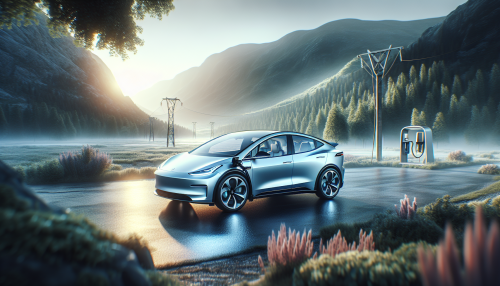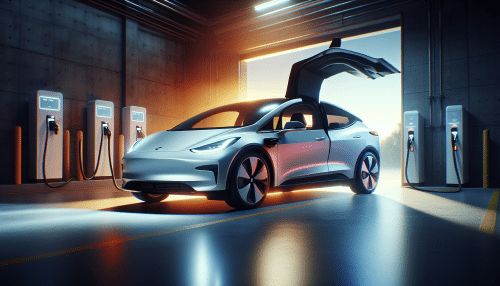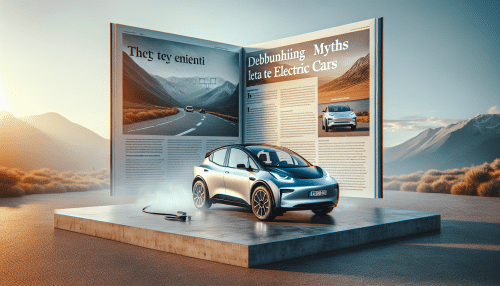Why Electric Cars Might Change How You Drive
Brian Taylor November 1, 2025
Curious about driving electric? This deep dive explores how electric cars influence everything from your daily commute to long-distance trips. Learn what makes electric vehicles unique, how charging works, and the real costs and benefits of making the switch.
What Sets Electric Cars Apart from Gas Vehicles
Electric cars have started to reshape the way many drivers think about commuting, travel, and environmental impact. Unlike traditional gas-powered cars, electric vehicles (EVs) use electric motors powered by rechargeable batteries to move. This difference holds significant implications for performance, efficiency, maintenance, and overall driving experience. The instant torque delivered by electric motors means that EVs can accelerate quickly from a standstill, offering a sensation some drivers describe as thrilling. This quick response is hard to find in conventional vehicles and serves as one of the notable benefits when considering an electric car.
Beyond the driving experience, low operational costs set electric cars apart. With fewer moving parts and no need for oil changes, maintenance tasks are drastically reduced. Owners often see long-term savings, especially when compared with regular trips to gas stations for fuel or for periodic exhaust system repairs. EVs are designed with regenerative braking systems that help recharge the battery every time the driver slows down, further maximizing efficiency. Reductions in maintenance work not only help save money but also reduce the time spent at mechanic shops, making EV ownership attractive for those who value convenience.
Another key distinction involves emissions. Electric cars do not rely on burning fossil fuels at the tailpipe, so they produce zero direct emissions while driving. This feature is central to their popularity among environmentally-conscious drivers. Since electricity can come from renewable sources like solar or wind, the total carbon footprint of EVs can be even lower. Many local governments and advocacy organizations highlight this aspect when promoting greener mobility. By switching to electric, drivers can actively contribute to cleaner air in urban spaces and reduced greenhouse gas emissions globally (https://www.epa.gov/greenvehicles/electric-vehicle-myths).
The Real Cost of Owning an Electric Vehicle
While the upfront sticker price of electric cars may seem higher than their gas-powered counterparts, the overall cost dynamics are more nuanced. EVs often qualify for government incentives, rebates, or tax credits designed to encourage adoption. These incentives can offset initial costs substantially and make electric cars more accessible than many people realize. Additionally, some workplaces and local municipalities offer grants for home charging station installation, which can further reduce costs. This structure of incentives is constantly evolving and varies by region, so it’s important to explore current opportunities in your area (https://afdc.energy.gov/laws/all?fuel=all&state=us).
Operating costs offer another important perspective. The main savings come from lower fuel expenses. Charging an electric vehicle, especially at home overnight, is generally more affordable than buying gasoline. For many owners, public fast-charging can be pricier but is used less frequently. Over years of driving, the cumulative cost savings can be significant. Studies have shown that electric car owners typically spend half as much or less on fueling their vehicles compared to those driving gas-powered cars.
Maintenance further tilts the math in favor of electric vehicles. EVs don’t require oil changes, exhaust system services, transmission repairs, or other gas-car-specific jobs. Fewer fluids, less frequent brake replacements due to regenerative braking, and fewer moving mechanical parts mean there are simply fewer things to break or wear out. Some drivers even report never needing more than tire rotations and cabin air filter replacements during their first years of ownership (https://www.energy.gov/eere/electricvehicles/saving-fuel-and-vehicle-costs).
Charging at Home and On the Go: What to Expect
One of the biggest shifts for new electric vehicle owners is how and where they refuel their cars. Home charging is likely to be the primary method for many drivers. Level 2 chargers, which typically require a dedicated outlet, offer a convenient way to fully recharge an EV overnight. Most automakers and local power companies provide guidance on installation and safety considerations. The comfort of waking up with a fully charged vehicle each morning appeals to those with regular daily driving routines.
Public charging infrastructure is continuously improving. Major cities and highways now offer hundreds of public charging stations, many equipped with high-speed DC fast chargers. These can add significant range in as little as 20 minutes, allowing for practical long-distance travel. Apps and interactive maps help locate stations and estimate charging times. Planning ahead is recommended, though advances in network coverage are making unexpected detours much less common (https://afdc.energy.gov/fuels/electricity_infrastructure.html).
Charging costs on public networks vary. Some charging stations are free, while others charge fees based on current, time, or subscription models. Understanding the landscape of available services is part of becoming an experienced EV driver. Some utilities also offer lower overnight electric rates for home charging, making the switch to electric cars even more attractive. For many, the key is finding the right mix of flexibility and convenience in their charging routines.
How Far Can You Travel? Understanding Range and Batteries
Range anxiety remains a prime concern for new electric vehicle drivers. The maximum distance an electric car can travel on a full charge depends on the battery’s capacity and the efficiency of the vehicle’s drivetrain. Newer EVs routinely offer ranges from 150 miles to well over 300 miles on a single charge. Battery technology continues to improve, resulting in better range year after year. Manufacturers frequently highlight tested range data to help buyers set realistic expectations for daily driving and longer road trips.
Batteries are the heart of an EV and require little day-to-day attention. However, long-term durability is a valid concern. Most manufacturers offer warranties covering battery life for 8 to 10 years or 100,000 miles. Studies suggest that modern lithium-ion battery packs degrade slowly, typically retaining 80% or more of their capacity after many years. Factors like extreme heat, regular use of DC fast charging, or high annual mileage can impact battery longevity, but advances in battery chemistry and thermal management provide protection (https://afdc.energy.gov/vehicles/electric_batteries.html).
Perceptions around range and batteries are evolving. Many drivers report quickly adjusting their routines once they realize how seldom they actually drive as far as they imagined. Simple changes, like monitoring charge levels and leveraging public fast chargers for longer trips, allow EVs to fit most modern lifestyles. For city commuting and daily errands, battery capacity rarely feels limiting.
Performance, Incentives, and the Benefits of Going Electric
Electric vehicles provide a unique driving experience thanks to instant torque delivery, smooth acceleration, and quiet operation. Many first-time EV drivers describe it as calming yet exhilarating—a combination not usually found in gas-powered cars. Low center of gravity, attributed to bottom-mounted batteries, also contributes to confident handling around corners and a more stable ride on highways.
Beyond driving enjoyment, a suite of government incentives and environmental benefits position electric cars as a compelling option. Incentives may include tax credits, access to high-occupancy vehicle (HOV) lanes, reduced registration fees, or free parking in select areas. These benefits can further enhance the value proposition, particularly alongside evolving fuel efficiency standards and environmental policies aimed at reducing carbon emissions (https://www.transportation.gov/policy-initiatives/electric-vehicles/electric-vehicle-incentives).
Environmental impacts reach beyond personal transportation. As the share of renewable energy on electrical grids increases, the footprint of charging electric vehicles shrinks. EVs even support grid stability through potential vehicle-to-grid (V2G) applications, where stored battery power could help balance supply and demand. Forward-thinking cities and companies are piloting these new technologies to promote sustainability initiatives. In this landscape, driving electric means participating in a much broader shift toward cleaner, more resilient infrastructure (https://afdc.energy.gov/vehicles/electric_emissions.html).
Overcoming Challenges and Common Questions About Electric Vehicles
Switching to an electric car brings up important questions for drivers used to gasoline vehicles. Charging infrastructure, battery replacement costs, and range are recurring concerns. As public awareness increases, companies and government agencies are actively working to expand charging networks and establish standards for battery recycling. Transparent warranty offerings ease concerns about large replacement bills. Proactive communication and education campaigns, hosted by advocacy groups and utility companies, aim to boost confidence in the electric transition.
Some drivers worry about winter performance, as cold weather can reduce battery efficiency. Manufacturers are addressing these challenges with improved battery management systems and insulated packs. Features like preconditioning—warming the battery and cabin while the car is still plugged in—help preserve range and driver comfort. Sharing real-world experiences through online forums and independent reports helps to spread knowledge about practical solutions and realistic expectations (https://www.edf.org/blog/2020/07/22/worried-about-switching-electric-car-here-are-answers-top-3-concerns).
Concerns around vehicle selection and resale value are evolving as the electric vehicle market grows. Today, options span compact city cars, luxury sedans, SUVs, and even pickup trucks. Battery improvements, growing consumer demand, and clear data on low maintenance costs are also driving healthy resale markets. The transition to electric vehicles may feel significant at first, but for many, it’s a leap toward innovation, efficiency, and responsible driving.
References
1. U.S. Environmental Protection Agency. (n.d.). Electric Vehicle Myths. Retrieved from https://www.epa.gov/greenvehicles/electric-vehicle-myths
2. U.S. Department of Energy. (n.d.). Saving Fuel and Vehicle Costs. Retrieved from https://www.energy.gov/eere/electricvehicles/saving-fuel-and-vehicle-costs
3. U.S. Department of Energy. (n.d.). Federal and State Laws and Incentives. Retrieved from https://afdc.energy.gov/laws/all?fuel=all&state=us
4. U.S. Department of Energy. (n.d.). Electric Vehicle Infrastructure. Retrieved from https://afdc.energy.gov/fuels/electricity_infrastructure.html
5. U.S. Department of Energy. (n.d.). Batteries for Electric Vehicles. Retrieved from https://afdc.energy.gov/vehicles/electric_batteries.html
6. Environmental Defense Fund. (2020). Worried about switching to an electric car? Here are answers to the top 3 concerns. Retrieved from https://www.edf.org/blog/2020/07/22/worried-about-switching-electric-car-here-are-answers-top-3-concerns





